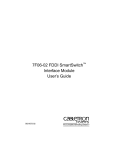Download Cabletron Systems Spectrum EMM-E6 User`s guide
Transcript
BRIM-F Book Page 1 Monday, January 29, 1996 9:26 AM BRIM-F6 USER’S GUIDE BRIM-F Book Page vii Monday, January 29, 1996 9:26 AM CONTENTS CHAPTER 1 1.1 1.2 1.3 1.4 1.5 Using This Manual ....................................................................... 1-2 Getting Help................................................................................. 1-2 BRIM-F6 Overview ...................................................................... 1-3 BRIM-F6 Features ....................................................................... 1-3 Related Documentation ............................................................... 1-4 CHAPTER 2 2.1 2.2 2.3 INTRODUCTION ......................................................... 1-1 INSTALLATION........................................................... 2-1 Unpacking the BRIM and the FPIM ............................................. 2-1 Installing FPIMs ........................................................................... 2-2 Installing the BRIM-F6 ................................................................. 2-3 2.3.1 Installing a BRIM-F6 into a MIM ..................................... 2-4 2.3.2 Installing a BRIM-F6 into a Hub...................................... 2-7 CHAPTER 3 USING LANVIEW ....................................................... 3-1 CHAPTER 4 SPECIFICATIONS....................................................... 4-1 4.1 4.2 4.3 4.4 4.5 Fiber Optic interface .................................................................... 4-1 Cable Specifications .................................................................... 4-5 Twisted Pair Pinout Configuration................................................ 4-7 Environment ................................................................................ 4-8 Safety .......................................................................................... 4-8 APPENDIX A A.1 A.2 A.3 A.4 A.5 A.6 A.7 BASIC FDDI NETWORKS .........................................A-1 Basic FDDI Concepts ..................................................................A-1 FDDI Media Access Protocol.......................................................A-1 Reliability .....................................................................................A-3 ANSI Standard X3T9.5 ................................................................A-4 FDDI Connection Rules...............................................................A-8 FDDI Devices ..............................................................................A-9 Design Considerations for FDDI Networks ................................A-14 A.7.1 Ring Length ..................................................................A-14 A.7.2 Drive Distance ..............................................................A-15 A.7.3 Attenuation ...................................................................A-15 A.7.4 Bandwidth.....................................................................A-16 A.7.5 Number of Stations.......................................................A-16 BRIM-F6 User’s Guide i BRIM-F Book Page 1 Monday, January 29, 1996 9:26 AM CHAPTER 1 INTRODUCTION Welcome to the Cabletron Systems BRIM-F6 User’s Guide. This manual describes features, explains installation procedures, and provides specifications for the BRIM-F6 — Cabletron Systems FDDI Bridge/ Router Interface Module (BRIM). The BRIM-F6 resides in, and provides additional connectivity/ functionality to, various Cabletron MIMs and hubs (e.g., the EMM-E6, ESXMIM, NBR-420/620 or MicroMMAC). The BRIM-F6 utilizes two FPIM (FDDI Port Interface Module) slots to provide you with the option of using multimode fiber optic, single mode fiber optic, unshielded twisted pair, or shielded twisted pair transceiver ports based on your network requirements. -F6 IM 6 S BR IM-FV ST S BR RC ST IM FP R FO FPIM R ED RV D FO SE E RE ERV S B RE IM FP B IM FP T V XM RC R T PW XM R K PW LN R NK W L T P R WR TW P K LN WR K LN IM FP R FO FPIM R ED RV D FO SE E RE ERV S A RE IM FP A IM FP Figure 1-1. BRIM-F6 BRIM-F6 User’s Guide Page 1-1 BRIM-F Book Page 2 Monday, January 29, 1996 9:26 AM CHAPTER 1: INTRODUCTION 1.1 Using This Manual Read through this manual completely to familiarize yourself with its content and to gain an understanding of the features and capabilities of the BRIM-F6. In addition to having a general working knowledge of Ethernet and IEEE 802.3 type data communications networks and their physical layer components, you should also understand FDDI networks and the ANSI X3T9.5 standard prior to installing the BRIM-F6. For a review of FDDI, see Appendix A, Basic FDDI Networks. Chapter 1, Introduction, outlines the contents of this manual, highlights BRIM-F6 features, and concludes with a list of related documentation. Chapter 2, Installation, describes how to install FPIMs into the BRIM-F6 and how to install the BRIM-F6 into a Media Interface Module (MIM) or a stand-alone hub. Chapter 3, Using LANVIEW, describes how to use the front panel LEDs to monitor BRIM performance. Chapter 4, Specifications, lists various electrical and physical specifications of the BRIM-F6. Appendix A, Basic FDDI Networks, covers basic concepts of FDDI networks, FDDI devices, and design/installation considerations. 1.2 Getting Help If you need additional support related to the BRIM-F6, or if you have any questions, comments, or suggestions concerning this manual, contact Cabletron Systems Technical Support: By phone ..........................(603) 332-9400 Monday-Friday; 8am - 8pm EST By CompuServe® GO CTRON from any ! prompt By Internet mail [email protected] Page 1-2 BRIM-F6 User’s Guide BRIM-F Book Page 3 Monday, January 29, 1996 9:26 AM BRIM-F6 Overview 1.3 BRIM-F6 Overview The BRIM-F6 is an FDDI Bridge Router Interface Module (BRIM) developed for use in Cabletron’s MMAC-FNB and MicroMMAC. The BRIM-F6 can be used to provide a high-speed uplink from lower speed networks such as Ethernet to a 100 Mbps FDDI backbone. 1.4 BRIM-F6 Features Connectivity The BRIM-F6 is equipped with slots for FDDI A and B ports. These two ports allow connection to the ring as a Dual Attached Station (DAS) using two FPIMs or as a Single Attached Station (SAS) using one FPIM. As a DAS, the MIM or hub that houses the BRIM-F6 connects directly to the FDDI main ring. This provides the reliability of an FDDI dual, counter-rotating ring topology. If one segment of the FDDI ring becomes disabled, this dual ring configuration provides redundancy and restores ring continuity. As a SAS, the BRIM-F6 connects to the primary ring only by using a single FPIM on the BRIM-F6 to attach to the M port of an FDDI concentrator. A dual homing configuration provides an additional redundancy feature for the MIM or hub containing the BRIM-F6. Dual homing is a way of connecting to an FDDI ring through the Master (M type) ports of two separate dual attached concentrators. If one M type port or one segment fails, the redundant port or segment activates automatically to retain connection to the ring. For more information regarding DAS, SAS or dual homing configurations, refer to Appendix A, Basic FDDI Networks. Bridging The BRIM-F6 provides translational bridging between any channels or ports in its host MIM or hub and the FDDI ring. BRIM-F6 User’s Guide Page 1-3 BRIM-F Book Page 4 Monday, January 29, 1996 9:26 AM CHAPTER 1: INTRODUCTION LANVIEW Diagnostic LEDs The BRIM-F6’s front panel LEDs help you diagnose Bridge, Port, and Network status. 1.5 Related Documentation Use the following documentation to supplement the procedures, and other technical data in this manual. This manual may reference procedures in these documents, where appropriate, but does not repeat them. Cabletron Systems’ EMM-E6 Installation Guide Cabletron Systems’ EMM-E6 Local Management Guide Cabletron Systems’ ESXMIM Installation Guide Cabletron Systems’ ESXMIM Local Management Guide Cabletron Systems’ MicroMMAC User’s Guide Cabletron Systems’ NBR-620/420/220 Installation Guide Cabletron Systems’ NBR-620/420/220 Local Management Guide Cabletron Systems’ Router Services Manuals The Simple Book, An Introduction to Management of TCP/IP-based Internets, Marshall T. Rose, Prentice-Hall, Inc., 1991. Page 1-4 BRIM-F6 User’s Guide BRIM-F Book Page 1 Monday, January 29, 1996 9:26 AM CHAPTER 2 INSTALLATION This chapter contains instructions for unpacking the BRIM-F6, installing FPIMs, and installing the BRIM-F6 into Cabletron devices that support BRIM technology. Note: The BRIM-F6 is not shipped with the FPIMs installed. You must order the correct FDDI Port Interface Modules based upon your network requirements. To install the BRIM and FPIMs, you need the following tools: • • 1 disposable wrist strap (provided with any BRIM, MIM or hub) 1 Phillips screwdriver. Caution: Observe all static precautions while handling modules. 2.1 Unpacking the BRIM and the FPIMs Unpack the modules as follows: 1. Remove the shipping box material covering the module. 2. Carefully remove the module from the shipping box. Leave the module in its static-shielding bag until you are ready to install. 3. After removing the module from its static-shielding bag, visually inspect the device. If you notice any signs of damage, contact Cabletron Systems Technical Support immediately. BRIM-F6 User’s Guide Page 2-1 BRIM-F Book Page 2 Monday, January 29, 1996 9:26 AM CHAPTER 2: INSTALLATION 2.2 Installing the FPIMs To install an FPIM into the BRIM-F6: 1. Remove the screws securing the FPIM coverplate and the coverplate. See Figure 2-1. 2. Insert the connector pins of the FPIM into the connector on the BRIM-F6. See Figure 2-2. FPIM Screws IM R D E RV FO FP SE RE IM R D E RV -F6 IM 6 S BR IM-FV ST S BRT RC V ST IM FP R FO FPIM R ED RV D FO SE E RE ERV S B RE IM FP B IM FP XM RC R T PW XM R K PW LN R K TW LN P R WR TW P K R N L W K N L FO FP SE RE A IM FP A IM FP FPIM Coverplate Figure 2-1. Removing the FPIM Coverplate 3. Press down firmly on the FPIM until the pins slide all the way into the connector holes. 4. Secure the FPIM with the screws provided. Page 2-2 BRIM-F6 User’s Guide BRIM-F Book Page 3 Monday, January 29, 1996 9:26 AM Installing the BRIM-F6 FPIM Screws FPIM Connector Standoffs -F6 IM 6 S BR IM-FV ST S BRT RC V ST IM D E RV OR F SE RE FP XM RC R T PW XM R K PW LN R K LN TW P R R W TW P K LN WR K LN IM FP R IM FO FP R ED RV D FO SE E RE ERV S E A R IM FP A IM FP B IM FP B IM FP Figure 2-2. Installing FPIMs 2.3 Installing the BRIM-F6 This section contains procedures on how to install a BRIM-F6 to upgrade or change the capabilities of a device’s motherboard. Note: Cabletron provides disposable wrist straps and faceplate and standoff screws in both the BRIM package and on devices that support BRIM technology. You can install a BRIM-F6 in any device that supports BRIM technology (e.g., EMM-E6, ESXMIM, NBR-420/620, or MicroMMAC). The following subsections provide instructions for installing a BRIM-F6 in a MIM or in a stand-alone hub. Refer to specific MIM or hub documentation for exact BRIM slot and connector locations. BRIM-F6 User’s Guide Page 2-3 BRIM-F Book Page 4 Monday, January 29, 1996 9:26 AM CHAPTER 2: INSTALLATION 2.3.1 Installing a BRIM-F6 into a MIM To install a BRIM-F6 in a Media Interface Module (MIM) that supports BRIM technology (e.g., EMM-E6): Note: We recommend that you power down your hub even though Cabletron MIMs have “hot swap” capabilities. 1. Power-down your MMAC hub. 2. Disconnect all cables from the module. Note each connection. 3. Unscrew the top and bottom knurled knobs of the MIM face plate. 4. Slide out the MIM, and place it on its side with the internal components facing up. 5. Remove the BRIM coverplate screws and the BRIM coverplate. Note: The BRIM-F6 requires an additional 24 pin ribbon connection. MIMs that support BRIMs provide one slot that supports this connection. Install the BRIM-F6 in the BRIM slot with the ribbon cable jack. 6. Remove BRIM standoff screws. 7. Place your BRIM behind the MIM faceplate. (See Figure 2-3.) 8. Insert the connector pins of the BRIM-F6 into the motherboard connector on the MIM. 9. Press down firmly on the back of the BRIM until the pins slide all the way into the connector holes. Note: Make sure that the standoffs align with the standoff screw holes. 10. Reinstall the faceplate mounting screws and standoff screws. Note: Faceplate and support post screws are provided both on the MIM and in the BRIM package, for your convenience. Page 2-4 BRIM-F6 User’s Guide BRIM-F Book Page 5 Monday, January 29, 1996 9:26 AM Installing the BRIM-F6 Standoff Screw BR V T WR Standoff -F6 IM Connector Pins Under BRIM S ST RC IM A FP XM P K R P K WR LN TW LN IM B FP Coverplate/ Faceplate Screws Motherboard Connector Figure 2-3. Installing the BRIM-F6 The BRIM-F6 requires a special 24 pin ribbon connector in addition to the standard 96 pin BRIM connector. This ribbon connector allows the BRIM-F6 to use in-line filtering functionality. BRIM-F6 User’s Guide Page 2-5 BRIM-F Book Page 6 Monday, January 29, 1996 9:26 AM CHAPTER 2: INSTALLATION To install the BRIM-F6 ribbon cable: 1. Insert one ribbon cable connector into the ribbon cable jack on the BRIM. (See Figure 2-4.) Tab Ribbon Cable Connector Groove S ST P R WR TW V T RC XM Ribbon Cable Jack Figure 2-4. Installing the BRIM-F6 Ribbon Cable Caution: The ribbon cable connector only fits into the ribbon cable jack one way. Fit the tab on the connector into the groove in the jack for correct cable orientation. 2. Press down on the connector until the clips on the jack snap into a vertical locked position. Page 2-6 BRIM-F6 User’s Guide BRIM-F Book Page 7 Monday, January 29, 1996 9:26 AM Installing the BRIM-F6 3. Insert the remaining ribbon cable connector into the ribbon cable jack on the MIM. 4. Press down on the connector until the clips on the jack snap into a vertical locked position. After returning the MIM to the chassis, returning power to your hub, and reconnecting to the network, the BRIM-F6 is now ready for operation. 2.3.2 Installing a BRIM-F6 into a Hub To install a BRIM-F6 into a stand-alone hub that supports BRIM technology (e.g., MicroMMAC): 1. Power-down your hub. 2. Disconnect all cables from the hub. Note the port-to-cable connections. 3. Remove the chassis cover. Note: Refer to specific hub documentation for instructions on removing the hub chassis cover. 4. Remove the BRIM coverplate/faceplate screws. Note: The BRIM-F6 requires an additional 24 pin ribbon connection. Hubs that support BRIM technology only provide one BRIM slot that supports this connection. Make sure you install the BRIM-F6 in the BRIM slot with the ribbon cable jack. 5. Remove BRIM standoff screws. 6. Remove the BRIM coverplate. 7. Place your BRIM behind the hub faceplate. (See Figure 2-3.) 8. Insert the connector pins of the BRIM-F6 into the motherboard connector in the hub. BRIM-F6 User’s Guide Page 2-7 BRIM-F Book Page 8 Monday, January 29, 1996 9:26 AM CHAPTER 2: INSTALLATION 9. Press down firmly on the back of the BRIM until the pins slide all the way into the connector holes. Note: Make sure that the standoffs align with the standoff screw holes. 10. Reinstall the coverplate/faceplate screws and standoff screws. Note: Faceplate and support post screws are provided both on the hub and in the BRIM package. The BRIM-F6 requires a special 24 pin ribbon connector in addition to the standard 96 pin BRIM connector. This ribbon connector allows the BRIM-F6 to use in-line filtering functionality. To install the BRIM-F6 ribbon cable: 1. Insert one ribbon cable connector into the ribbon cable jack on the BRIM. (See Figure 2-4.) Caution: The ribbon cable connector only fits into the ribbon cable jack one way. Fit the tab on the connector into the groove in the jack for correct cable orientation. 2. Press down on the connector until the clips on the jack snap into a vertical locked position. 3. Insert the remaining ribbon cable connector into the ribbon cable jack in the hub. 4. Press down on the connector until the clips on the jack snap into a vertical locked position. After returning the cover, returning power to your device, and reconnecting to the network, your BRIM-F6 is now ready for operation. Page 2-8 BRIM-F6 User’s Guide BRIM-F Book Page 1 Monday, January 29, 1996 9:26 AM CHAPTER 3 USING LANVIEW LANVIEW is a visual diagnostic and status monitoring system developed by Cabletron Systems. LANVIEW LEDs (see Figure 3-1) help you troubleshoot Bridge, Port, and Network problems. The following sections describe BRIM-F6 LEDs. BRIM-F6 PWR XMT RCV STS FPIM B FPIM A LNK WRP TWR LNK Figure 3-1. BRIM-F6 LANVIEW LEDs PWR (Power) When ON, this Green LED indicates that power is supplied to the BRIM. STS (Status) This multi-state LED can indicate the following: Green The station attached to the port is connected to the network. Amber The BRIM is in standby mode; the BRIM is not bridging traffic. Red or Flashing Red LED off BRIM-F6 User’s Guide The port or the entire BRIM has failed, or the FDDI ring is not operational. The port has no valid connector attached. Page 3-1 BRIM-F Book Page 2 Monday, January 29, 1996 9:26 AM CHAPTER 3: USING LANVIEW TWR (Twisted Ring) When ON, this Red LED indicates an undesirable cable connection. TWR illuminates when you connect A to A, or B to B, instead of A to B, or B to A. The BRIM-F6 supports undesirable configurations, but alerts you to them. (Appendix A summarizes FDDI connection rules.) WRP (Wrap) This Red LED is ON when the BRIM-F6 detects an FDDI ring wrap. This means there is a break in the ring, and the system has combined the primary and secondary rings into one ring. XMT (Transmit) When ON, this Green LED indicates that the BRIM-F6 is transmitting traffic to the FDDI network. On a network with average traffic, the XMT LED normally flashes. RCV (Receive) When ON, this Amber LED indicates that the BRIM-F6 is receiving FDDI traffic. On a network with average traffic, the RCV LED normally flashes. LNK (Media Link OK) When ON, this Green LED indicates that a connection exists between the BRIM-F6 and the node at the other end of the port cable segment. To ensure you maintain the link, the port generates an idle signal when not transmitting data. When OFF, this LED indicates that either nothing is connected to the BRIM-F6, or the port is not receiving any signal. Page 3-2 BRIM-F6 User’s Guide BRIM-F Book Page 1 Monday, January 29, 1996 9:26 AM CHAPTER 4 SPECIFICATIONS This chapter lists the operating specifications for the BRIM-F6. Cabletron Systems reserves the right to change these specifications at any time, without notice. 4.1 Fiber Optic Interface Depending on the FPIM, interfaces have the following characteristics: Multimode Specifications Multimode Transmitter Optical wavelength: 1330 nm typical Optical output: -20.0 dBm minimum -14.0 dBm maximum Optical rise time: 3.5 nsec maximum Optical fall time: 3.5 nsec maximum Spectral width: 140 nm typical Supply current: 150 mAmps maximum Multimode Receiver Optical wavelength: 1330 nm typical Optical input: (avg. sensitivity) -31.0 dBm minimum -14.0 dBm maximum Output rise time: 3 nsec maximum Output fall time: 3 nsec maximum Supply current: 150 mAmps maximum BRIM-F6 User’s Guide Page 4-1 BRIM-F Book Page 2 Monday, January 29, 1996 9:26 AM CHAPTER 4: SPECIFICATIONS Multimode Receiver (Signal Detect) Assert power: -33.0 dBm typical -31.0 dBm maximum Assert time: 10 µsec typical 100 µsec maximum Deassert power: -36.0 dBm typical -45.0 dBm minimum Deassert time: 10 µsec typical 350 µsec maximum Hysteresis: 1.5 dB minimum Single Mode Specifications Single Mode Transmitter Page 4-2 Optical wavelength: 1330 nm typical Optical output: -20.0 dBm minimum -14.0 dBm maximum Optical rise time: 3.5 nsec maximum Optical fall time: 3.5 nsec maximum Spectral width: 150 nm maximum Supply current: 150 mAmps maximum BRIM-F6 User’s Guide BRIM-F Book Page 3 Monday, January 29, 1996 9:26 AM Single Mode Specifications Single Mode Receiver Optical wavelength: 1330 nm typical Optical input: (avg. sensitivity) -31.0 dBm minimum -14.0 dBm maximum Output rise time: 3 nsec maximum Output fall time: 3 nsec maximum Supply current: 115 mAmps maximum Single Mode Receiver (Signal Detect) Assert power: -33.0 dBm typical -31.0 dBm maximum Assert time: 10 µsec typical 100 µsec maximum Deassert power: -36.0 dBm typical -45.0 dBm minimum Deassert time: 10 µsec typical 350 µsec maximum Hysteresis: 1.5 dB minimum BRIM-F6 User’s Guide Page 4-3 BRIM-F Book Page 4 Monday, January 29, 1996 9:26 AM CHAPTER 4: SPECIFICATIONS Unshielded Twisted Pair Specifications Unshielded Twisted Pair Transmitter Amplitude 1.080 Vpk maximum 0.920 Vpk minimum Rise time 2 nsec minimum 4 nsec maximum Fall time 2 nsec minimum 4 nsec maximum Rise/Fall variation 0.5 nsec maximum Overshoot 5% maximum Droop (14 symbols) 3% maximum Unshielded Twisted Pair Receiver (Signal Detect) Assert time Page 4-4 10 µsec typical 100 µsec maximum BRIM-F6 User’s Guide BRIM-F Book Page 5 Monday, January 29, 1996 9:26 AM Shielded Twisted Pair Transmitter Specifications Unshielded Twisted Pair Receiver (Signal Detect) Deassert time 10 µsec typical 350 µsec maximum Shielded Twisted Pair Transmitter Specifications Shielded Twisted Pair Transmitter Amplitude 1.285 Vpk maximum 1.165 Vpk minimum Rise time 3 nsec minimum 5 nsec maximum Fall time 3 nsec minimum 5 nsec maximum Rise/Fall variation 0.5 nsec maximum Overshoot 5% maximum Shielded Twisted Pair Receiver (Signal Detect) 4.2 Assert time 10 µsec typical 100 µsec maximum Deassert time 10 µsec typical 350 µsec maximum Cable Specifications The FDDI Physical Layer Medium Dependent (PMD), Twisted Pair Physical Layer Medium Dependent (TP-PMD), and Single Mode Fiber Physical Layer Medium Dependent (SMF-PMD) ANSI standards define cable requirements as follows: BRIM-F6 User’s Guide Page 4-5 BRIM-F Book Page 6 Monday, January 29, 1996 9:26 AM CHAPTER 4: SPECIFICATIONS Multimode Fiber: Core diameter: 62.5 µm nominal Cladding diameter: 128.0 µm maximum 122.0 µm minimum Cable attenuation: ≤ 2.5 dB/km typical Single Mode Fiber: Core diameter: 8.7 µm +/- 0.5 µm Cladding diameter: 127.0 µm maximum Cable attenuation: ≤ 0.5 dB/km typical Multimode Fiber Optic Cable Length The PMD FDDI standard specifies the following: Maximum total cable length: Maximum multimode cable length between adjacent nodes: 100 km (62 miles) — dual ring 200 km (124 miles) — wrapped 2 km (1.2 miles) Single Mode Fiber Optic Cable Length The SMF-PMD FDDI standard specifies the following: Maximum total cable length: Single mode cable length between adjacent nodes: 100 km (62 miles) — dual ring 200 km (124 miles) — wrapped 40 km (24 miles) maximum 25 km (15 miles) typical Twisted Pair Cable Length The TP-PMD FDDI standard specifies the following: Page 4-6 BRIM-F6 User’s Guide BRIM-F Book Page 7 Monday, January 29, 1996 9:26 AM Twisted Pair Cable Length Maximum total cable length: 100 km (62 miles) — dual ring 200 km (124 miles) — wrapped Maximum twisted pair cable length between adjacent nodes: 4.3 100 m (328.1 feet) Twisted Pair Pinout Configuration This section provides the RJ-45 pinout configuration for Unshielded Twisted Pair (UTP) and Shielded Twisted Pair (STP) Physical Layer Medium Dependent (PMD) ports. Note: When connecting two twisted pair ports together, a transmit and receive cross-over must occur between the two devices (within the cable). Pin 1 Pin 8 Figure 4-1. RJ-45 TP-PMD Port Contact Signal 1 Transmit + 2 Transmit - 3 N/A 4 N/A 5 N/A BRIM-F6 User’s Guide Page 4-7 BRIM-F Book Page 8 Monday, January 29, 1996 9:26 AM CHAPTER 4: SPECIFICATIONS Contact 4.4 4.5 Signal 6 N/A 7 Receive + 8 Receive - Environment Storage temperature: -40°C minimum 85°C maximum Operating temperature: 5°C minimum 40°C maximum Operating humidity: 5% to 95% non-condensing Safety This unit meets the safety requirements of UL 1950, CSA C22.2 No. 950, and EN 60950; the EMI requirements of FCC Class A and EN 55022 Class A; and the EMC requirements of EN 50082-1. Note: It is the responsibility of the person who sells the system to which the BRIM will be a part to ensure that the total system meets allowed limits of conducted and radiated emissions. Page 4-8 BRIM-F6 User’s Guide BRIM-F Book Page 1 Monday, January 29, 1996 9:26 AM APPENDIX A BASIC FDDI NETWORKS This Appendix covers basic Fiber Distributed Data Interface (FDDI) network concepts relating to FDDI network design and installation. ANSI Standard X3T9.5 provides greater detail on FDDI access methods. Reference this standard whenever you need more complete information. Specific areas presented here include: • Basic FDDI Concepts • FDDI Devices • Design and Installation Considerations. A.1 Basic FDDI Concepts An FDDI network provides a high-speed (100 Mbit/sec.), fiber optic network capable of reliable data transmission. The fiber optic media provides increased bandwidth, immunity from electrical noise, security, and permits the use of longer cable segments. These features make FDDI a viable alternative in LAN backbone applications, or as a back-end or front-end network between processors. A.2 FDDI Media Access Protocol The FDDI standard X3T9.5 describes the media access and token passing protocol for FDDI networks. Each station on an FDDI ring has a unique station address, differentiating it from all other stations. A special frame, called a token, controls transmission. Only one station, the station holding the token, can transmit at any given time. This token circulates around the ring from station to station. Each station receives the token from the station preceding it on the ring, retains it while transmitting data (frames) and then passes (transmits) the token on to the next active station on the ring. BRIM-F6 User’s Guide Page A-1 BRIM-F Book Page 2 Monday, January 29, 1996 9:26 AM APPENDIX A: BASIC FDDI NETWORKS When a station has a frame waiting to transmit, the station captures the token at the next opportunity, transmits the data frame, and then reissues the token. (A Token Holding Timer (THT) controls the maximum length of time that any station may retain the token.) Each station receives and repeats the data frame as it circulates around the ring. When the frame arrives at the station defined by the destination address, the receiving station copies the frame into its buffer and forwards with information reflecting the receipt of the frame and related frame status. After the data frame circulates completely around the ring, the source station strips the data frame from the ring. FDDI networks use duplex fiber optic cable for point-to-point connections between a number of stations to form two closed loops. The two rings serve as redundant (primary and secondary) data paths that operate as counter-rotating rings. Redundant rings facilitate recovery procedures in the event of a ring segment failure. This recovery resembles that in Token Ring/IEEE 802.5 networks. This Appendix discusses this in greater detail later in this section. The FDDI standard defines two ring access methods, single attachment and dual attachment (see Figure A-1). Dual attached stations (DAS) and dual attached concentrators (DAC) connect to both primary and secondary rings and can restore ring continuity in the event of a segment failure. Single attached stations (SAS) and single attached concentrators (SAC) cannot restore ring continuity and therefore cannot reside on the main ring path. Single attached devices access the main ring through a DAC and duplex fiber optic cable connections. These connections form branches that extend from the DAC out to each of the attached SASs, creating a Ring of Trees topology. The DAC controls main ring access to the attached SASs, restoring the continuity of the ring whenever an SAS fails, becomes disconnected, or is turned-off. Page A-2 BRIM-F6 User’s Guide BRIM-F Book Page 3 Monday, January 29, 1996 9:26 AM Reliability Ethernet/802.3 Network Ethernet/802.3 Network ETHERNET to FDDI BRIDGE ETHERNET to FDDI BRIDGE FDDI NETWORK DUAL ATTACHED STATION File Server DUAL ATTACHED CONCENTRATOR SINGLE ATTACHED CONCENTRATOR Single Attached Stations Figure A-1. Typical FDDI Physical Installation A.3 Reliability FDDI networks employ a ring topology and are inherently vulnerable to the frailties of each ring segment and failures of individual stations. The ring of trees topology reduces the risk of a single node bringing the entire network down. A redundant data path, within the main ring trunk cabling, further reduces this vulnerability. In theory, to achieve the circular data flow, the ring topology requires media that allows only one-way traffic. In practice, an FDDI ring uses media that provides two fiber optic ring paths, a primary ring and a secondary ring. The secondary ring restores the continuity of the ring in the event a node fails node or a trunk segments (a trunk cable breaks). Figure A-2 illustrates how the open ends of the primary ring wrap into the secondary ring, restoring continuity by creating a new ring. BRIM-F6 User’s Guide Page A-3 BRIM-F Book Page 4 Monday, January 29, 1996 9:26 AM APPENDIX A: BASIC FDDI NETWORKS CONCENTRATOR 3 PRIMARY RING B WRAP A B SECONDARY RING A CONCENTRATOR 4 CONCENTRATOR 2 B A B A CONCENTRATOR 1 Figure A-2. Wrapping a Broken Ring A.4 ANSI Standard X3T9.5 The X3T9.5 standard includes: Station Management (SMT), Media Access Control (MAC), Physical Layer Medium Dependent (PMD) standards and Physical Layer Protocol (PHY). Each section defines a unique entity of the FDDI station architecture and its operation. The X3T9.5 entities perform many of the lower layer functions of the OSI network model Data Link and Physical Layers (Figure A-3). Page A-4 BRIM-F6 User’s Guide BRIM-F Book Page 5 Monday, January 29, 1996 9:26 AM ANSI Standard X3T9.5 Application Data Link Presentation LLC Session Transport Network MAC Media Access Control • Medium Addressing • Data Checking • Data Framing SMT Station Management • Fault Isolation and Recovery • Station Configuration • Scheduling Procedures Data Link Physical Physical PHY Physical Layer Protocol • Symbol Coding/Decoding • Symbol Framing • Clock Rate PMD or SMF-PMD Physical Layer Medium Dependent • Power Levels • Transmitter • Receiver • Optical Interface • Connector Types Figure A-3. FDDI Structure and the OSI Network Model The PMD standard establishes the physical characteristics of the network connection, including the fiber optic transmitter power levels, receiver sensitivity, the fiber optic cable type, the type of connectors, and acceptable losses between nodes. The PMD converts the optically encoded information that it receives to electrically encoded information and presents it to the PHY sublayer. The layers reverse this process when transmitting information. The PHY entity implements the physical layer protocol. The PHY receives data frames from the MAC as a series of 4-bit symbols and encodes each 4-bit MAC symbol as a 5-bit symbol for transmission. This encoding occurs to ensure each symbol has at least two bit transitions for bit-cell synchronization at the remote receiver. Decoding reverses this process for the received frames. BRIM-F6 User’s Guide Page A-5 BRIM-F Book Page 6 Monday, January 29, 1996 9:26 AM APPENDIX A: BASIC FDDI NETWORKS Other functions of the PHY include generation of a 125 Mhz transmit clock, synchronization of the receive clock with an upstream transmitter, encoding and decoding for media control symbols, and in some applications, buffering for the incoming bit stream. The MAC entity resides on the lower sublayer of the Data Link layer. The upper sublayer, Logical Link Control (LLC) serves as an interface between the OSI model and the FDDI network. The MAC element, under control of Station Management, performs many of the tasks associated with frame preparation and media access: ring scheduling, token generation, timers that monitor ring activity, ring initialization, and beaconing. Other tasks for the MAC entity include assembling data frames, maintaining medium addressing, and generating and checking data check bytes. The MAC generates two basic message formats, tokens and frames. Figure A-4 shows the layout for each message. Control and format bits within the header define specific types of frames and classes of tokens. The MAC sublayer receives transmittable Data frames from the LLC as Service Data Units (SDUs). MAC uses these SDUs to construct Protocol Data Units (PDUs) that it passes on to PHY. The PDUs consist of a MAC header, the encapsulated SDU, and a Frame Check Sequence (FCS). The MAC generates FCS during transmission. TOKEN Starting Frame Ending Preamble Delimiter Control Delimiter ≥ 16 Symbols 2 Symbols 2 Symbols 2 Symbols JK FRAME TT Frame Check Sequence Coverage T Starting Frame Frame Check Ending Preamble Address Source Address Information Control Destination Delimiter Frame Status ≥ 16 Symbols 2Delimiter 4 or 12 Symbols 4 or 12 Symbols ≥ 0 Symbol Pairs 8Sequence Symbols 2 Symbols Symbols 1 Symbols ≥ 3 Symbols Maximum - 9000 Symbols Figure A-4. Token and Frame Formats Page A-6 BRIM-F6 User’s Guide BRIM-F Book Page 7 Monday, January 29, 1996 9:26 AM ANSI Standard X3T9.5 SMT (Station Management) manages the FDDI station. It controls internal FDDI station processes and protocol compliance and provides an interface for human intervention. Internal SMT management functions consist of three major categories: SMT Frame Services, Ring Management (RMT), and Connection Management (CMT). Interfaces from SMT to each of these station components permit monitoring and control for a variety of station functions (see Figure A-5). LLC FDDI STATION SMT SMT Frame Services MAC LAN Management (Agent) Ring Management Configuration Path Switch Configuration Management PHY Physical Connection Management PMD Bypass Switch (optional) In Bypass Switch Control Out Figure A-5. SMT Management Organization SMT Frame Services generates and interprets special FDDI frames that assist in network control and monitoring. Ring Management (RMT) monitors status information from the MAC and Configuration Management and controls several functions relating to the health of the ring. BRIM-F6 User’s Guide Page A-7 BRIM-F Book Page 8 Monday, January 29, 1996 9:26 AM APPENDIX A: BASIC FDDI NETWORKS Connection Management (CMT) controls physical layer insertion and removal of stations. CMT has three main components: • Entity Coordination Management (ECM) controls bypass switches and coordinates trace (recovery) functions. • Configuration Management (CFM) controls PHY and MAC entity configuration within a node. Attaching or removing a station from the ring changes the logical structure of the ring. • Physical Connection Management (PCM) controls the physical connection between adjacent PHYs. It tests the quality of the link and enforces connection rules, screens marginal connections, and supports maintenance activities. A.5 FDDI Connection Rules One of the primary functions of SMT Connection Management is to control physical connections among A, B, M, and S type ports. The following table summarizes the FDDI connection rules. A B S M A V,U V V,U V,P B V V,U V,U V,P S V,U V,U V V M V V V X V - valid connection X - illegal connection U - undesirable connection P - valid, but when both A and B connect to M ports, only the B connection is active. Connecting A and B to M ports creates a dual homing configuration. Dual homing provides a redundant topology for concentrators. Figure A-6 illustrates how to configure three concentrators into dual homing configuration. Page A-8 BRIM-F6 User’s Guide BRIM-F Book Page 9 Monday, January 29, 1996 9:26 AM FDDI Devices Port A Port A Port B 1 Port M Port B 2 Port M Backup Connection Port M Port M Primary Port B Connection Port A 3 Figure A-6. Dual Homing Topology Concentrator 3 in Figure A-6 has redundant connections to the main ring through either concentrator 1 or 2. The FDDI connection rules only permit one active connection, Port B. If a cable failure severs concentrator 3’s connection to concentrator 2, CFM activates Port A. A.6 FDDI Devices FDDI recognizes four station configurations (SAS, DAS, DAC, and SAC). These configurations differ by the mix of FDDI entities within the station (see Figure A-7). All stations must have: • • • • one SMT at least one MAC one PMD one PHY. BRIM-F6 User’s Guide Page A-9 BRIM-F Book Page 10 Monday, January 29, 1996 9:26 AM APPENDIX A: BASIC FDDI NETWORKS Each physical ring connection requires: • • one PMD one PHY. A SAS consists of: • • • • one SMT one MAC one PMD one PHY. A DAS consists of: • • two PMDs two PHYs. Single Attached Concentrator Dual Attached Concentrator PMD-3 PMD-2 PMD-1 PHY-3 PHY-2 PHY-1 MAC MAC PMD-3 PMD-2 PMD-1 PHY-3 PHY-2 PHY-1 MAC PHY PMD SMT In SMT PHY-A PHY-B PMD-A PMD-B Secondary Out Primary In Out MAC MAC Secondary In Primary Out MAC PHY PHY-A PHY-B PMD-A PMD-B PMD SMT SMT Single Attached Station Dual Attached Station In Out Primary In Secondary Out Secondary In Primary Out Figure A-7. Valid Station Configurations Page A-10 BRIM-F6 User’s Guide BRIM-F Book Page 11 Monday, January 29, 1996 9:26 AM FDDI Devices FDDI devices physically attach to the ring using Fixed Shroud Duplex (FSD) media interface connectors. The X3T9.5 Physical Layer, PMD standard defines four connector types (see Figure A-7). These connectors provide proper trunk fiber alignment for each of the valid configurations. Types A, B, and M provide precision connection (i.e., mechanical keying to assure proper connection to Primary-In and Primary-Out fibers). Types A and B allows dual attachment to the primary and secondary data paths of the main ring. Type M allows for single attachment stations, at a concentrator end of the SAS lobe. The Type S connector has a wide, centrally located, keyway provides nonprecision connection (i.e., for SAS lobe attachment). FDDI RECEPTACLES PRIMARY IN FDDI CONNECTORS SECONDARY OUT Type A TYPE A Dual DUAL Attachment ATTACHMENT SECONDARY IN PRIMARY OUT Type B TYPE B IN OUT Type M TYPE M SINGLE Single ATTACHMENT Attachment IN OUT Type S TYPE S Figure A-8. Duplex Fiber Optic Receptacles and Connectors BRIM-F6 User’s Guide Page A-11 BRIM-F Book Page 12 Monday, January 29, 1996 9:26 AM APPENDIX A: BASIC FDDI NETWORKS Optical bypass switches, concentrators, and bridges exist throughout FDDI networks. These devices allow creation of ring topologies that meet the specific needs of different network applications. Repeaters, often found in other network topologies, do not exist as entities for FDDI networks. This is because all devices that attach to the FDDI main ring must comply with FDDI protocol. In other words, they must dual attach to the ring and have, as a minimum, two PMD and PHY entities and one MAC and SMT entity. Since a DAS or DAC can match this configuration, either could serve as a repeater when a main ring segment must extend beyond the 2 km maximum between nodes. Together with Figure A-10, the following descriptions provide a brief introduction to several FDDI components and their network functions. In many cases, specific functions combine in a single device. An optical bypass switch allows insertion between a station and the FDDI ring connections without having to remove the station from the ring and disturbing ring continuity. These devices, often electrically actuated, provide passive optical switching of both the primary and secondary ring cables. Figure A-9 shows the data paths through the switch in both the bypass and operational (non-bypassed) states. Page A-12 BRIM-F6 User’s Guide BRIM-F Book Page 13 Monday, January 29, 1996 9:26 AM FDDI Devices BYPASS STATE Station Power Off OPERATIONAL STATE Station Power On STATION STATION FDDI Dual Optical Bypass Switch FDDI Dual Optical Bypass Switch FDDI RING FDDI RING Figure A-9. Optical Bypass Switch A concentrator is a hub. It provides connections to the dual ring for single attached stations and controls their access to the ring. The network can optically bypass each main ring connection if the attached station becomes disabled or when the branch cable is disconnected. Bridging devices for FDDI connect multiple FDDI networks and link an FDDI ring to a network that uses a different MAC layer protocol (Token Ring or Ethernet). A bridge does not expand an existing FDDI ring, it connects rings. Bridges that link two different MAC layer protocols, such as FDDI and Ethernet, typically use one of two bridging techniques, encapsulation or translation. Translation bridges translate frames from a non-FDDI MAC layer protocol to FDDI, allowing, for instance, an Ethernet station to talk to an FDDI station. Encapsulation bridges enclose the non-FDDI frames within the FDDI protocol. These bridges work in pairs – the sending bridge encapsulates the message and the receiving bridge strips the FDDI protocol, restoring the original frame. The bridge maintains routing information for filtering (prevent frames from crossing the bridge) or forwarding messages across the bridge. BRIM-F6 User’s Guide Page A-13 BRIM-F Book Page 14 Monday, January 29, 1996 9:26 AM APPENDIX A: BASIC FDDI NETWORKS Ethernet/802.3 Network Single Attached Stations File Server Ethernet/802.3 Network ETHERNET to FDDI BRIDGE ETHERNET to FDDI BRIDGE FDDI NETWORK DUAL ATTACHED CONCENTRATOR FDDI to FDDI BRIDGE FDDI NETWORK DUAL ATTACHED STATION DAS Ethernet/802.3 Network DUAL ATTACHED CONCENTRATOR DUAL ATTACHED CONCENTRATOR ETHERNET to FDDI BRIDGE SINGLE ATTACHED CONCENTRATOR Single Attached Stations Figure A-10. FDDI Devices A.7 Design Considerations For FDDI Networks The main variables of interest to the FDDI network designer include ring length, drive distance (distance between nodes), and the maximum number of stations. While many factors determine the limits for these design elements, this section examines the ANSI standard and focuses on those factors that you can control in your network. A.7.1 Ring Length The maximum FDDI Ring Length is 100 km. ANSI standard X3T9.5 indirectly sets this limit by, instead of specifying ring length, defining default design parameters based on a total fiber path length of 200 km. Page A-14 BRIM-F6 User’s Guide BRIM-F Book Page 15 Monday, January 29, 1996 9:26 AM Design Considerations For FDDI Networks To translate fiber path to ring length, remember that FDDI networks contain two counter-rotating rings. Under normal conditions (no failed segment), the ring length remains the same as the fiber path length. However, if a wrap occurs, the length of the fiber path length could nearly double. To safely establish the maximum ring length, divide the fiber length by two. This yields a maximum ring length 100 km (one-half of the 200 km fiber path length). In designing your network, you must add all of the lengths of the fiber optic cables in your network to determine the total ring length. This includes main ring cables and branch cables that reach from concentrators to SASs. A.7.2 Drive Distance Drive distance is the limit of reliable signal propagation around the ring. (i.e., the greatest distance that a signal can travel on the ring and still be reliably received). For FDDI networks using multimode fiber the maximum drive distance is 2 km. For networks using single mode fiber, the maximum drive distance is up to 40 km (25 km typical) depending on transceiver type. To the network designer, this means that the maximum cable length between any two network nodes must not exceed the 2 km maximum distance limit for multimode or 25 km typical distance for single mode. In some multimode applications, existing 50/125 µm or 100/140 µm fiber operates over longer distances. However, the cable must conform to the FDDI standard for bandwidth and attenuation to remain compliant with the FDDI standard. The 40 km maximum for single mode fiber is for absolute best-case (i.e., not for practical application). A.7.3 Attenuation The maximum attenuation (attenuation budget) between any two active connections to the ring, according to the FDDI standard, is 11 dB. This budget includes the attenuation of the cabling, splices, connections, and optical bypass switches. BRIM-F6 User’s Guide Page A-15 BRIM-F Book Page 16 Monday, January 29, 1996 9:26 AM APPENDIX A: BASIC FDDI NETWORKS The attenuation of the typical multimode fiber optic cable used in FDDI networks is 2.5 dB/km or 5 dB for the 2 km maximum node separation. When installing optical bypass switches, each switch could add 2.5 dB to the attenuation. With an 11 dB budget to work with, and 5 dB expended on the cable, you can install a maximum of two bypass switches. A.7.4 Bandwidth The minimum modal bandwidth of fiber optic cable used in an FDDI network is 500 Mhz at 1300 nm. A.7.5 Number of Stations The number of devices in a single FDDI ring cannot exceed 500. The amount of propagation delay generated by 1000 physical connections determines this limit. With the exception of optical bypass switches, all FDDI devices count as two connections against the 1000 physical connection budget. You can easily see how to calculate this number when only dual attached stations reside on the network (1000 divided by 2 connections for each DAS = 500 nodes). However, to understand how to count connections for other device types, refer to Figure A-11. A DAC without attached devices counts as two connections (main ring connections), the same as a DAS. As you attach each additional SAS or SAC to the DAC, you must count two connections against the budget, one for the concentrator port and one for the attached device. This same logic applies to counting connections for a SAC. The multiple ports of the concentrator do not count until you attach a device. Page A-16 BRIM-F6 User’s Guide BRIM-F Book Page 17 Monday, January 29, 1996 9:26 AM Design Considerations For FDDI Networks DAS 2 16 PHYSICAL CONNECTIONS DAC 1 +1 2 2 SAC 2 2 SAS 2 SAS 2 SAS 2 SAS 2 SAS Figure A-11. Physical Device Connections BRIM-F6 User’s Guide Page A-17






















































